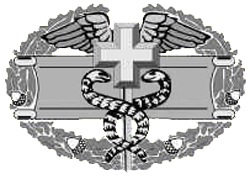 The Combat Medical Badge (CMB), or Medical Badge as it was initially called, was established by the War Department in March 1945. It was created as a means to recognize the important role performed by medical personnel assigned or attached to infantry units, and who on a daily basis shared the same hazards and hardships of combat in World War II. The need to establish a badge for medical personnel was a result of the Combat Infantry Badge (CIB) being established on 27 October 1943 for the infantryman, who was subjected to the worst conditions in combat, sustained the most casualties and receiving very little, if any, recognition for their sacrifice and heroic actions. The CIB could only be awarded to infantrymen. While it was recognized that other personnel, like the medics, served along side these gallant soldiers, suffered the same hardships of combat, and often died on the battlefield treating their comrades, no exceptions were made for this prestigious award. This new infantryman's badge led to many requests and recommendations to create special combat badges for medical personnel and other components of the army; however the War Department disapproved all of these initiatives. The Army Medical Department continued its efforts to have a combat badge established for its personnel serving in infantry units. The War Department finally approved the Medical Badge for medical personnel in WD Circular 66, dated 1 March 1945, and made it retroactive to 7 December 1941. The approval of the Medical Badge did not include the $10.00 extra pay a month that was authorized to an infantryman who earned the CIB. While the issue of extra pay was being addressed, the infantryman certainly had no objections to the medic or "DOC", as he was commonly referred to in the unit, to receive equal pay. One infantry unit took matters in their own hands and took up a collection from its members for their medics who "shared their dangers but not their pay". In July 1945, extra pay was approved for medical personnel who served in infantry units. In February 1951, the war department approved the addition of stars to the CMB to indicate subsequent awards of the badge in separate wars or conflicts. Multiple awards of the CMB is limited to WW II, Korean Conflict and Vietnam. The rules for award of the CMB have been expanded to include Army medical personnel who served in armor and ground cavalry units during Desert Shied/Storm. Medical personnel of the Navy and Air Force who have been assigned or attached to similar Army units engaged in active ground combat may also be awarded the CMB. The CMB is one of the most coveted awards a "Soldier Medic" can earn and certainly has been and always will be the ultimate "Portrait of Courage".
The Combat Medical Badge (CMB), or Medical Badge as it was initially called, was established by the War Department in March 1945. It was created as a means to recognize the important role performed by medical personnel assigned or attached to infantry units, and who on a daily basis shared the same hazards and hardships of combat in World War II. The need to establish a badge for medical personnel was a result of the Combat Infantry Badge (CIB) being established on 27 October 1943 for the infantryman, who was subjected to the worst conditions in combat, sustained the most casualties and receiving very little, if any, recognition for their sacrifice and heroic actions. The CIB could only be awarded to infantrymen. While it was recognized that other personnel, like the medics, served along side these gallant soldiers, suffered the same hardships of combat, and often died on the battlefield treating their comrades, no exceptions were made for this prestigious award. This new infantryman's badge led to many requests and recommendations to create special combat badges for medical personnel and other components of the army; however the War Department disapproved all of these initiatives. The Army Medical Department continued its efforts to have a combat badge established for its personnel serving in infantry units. The War Department finally approved the Medical Badge for medical personnel in WD Circular 66, dated 1 March 1945, and made it retroactive to 7 December 1941. The approval of the Medical Badge did not include the $10.00 extra pay a month that was authorized to an infantryman who earned the CIB. While the issue of extra pay was being addressed, the infantryman certainly had no objections to the medic or "DOC", as he was commonly referred to in the unit, to receive equal pay. One infantry unit took matters in their own hands and took up a collection from its members for their medics who "shared their dangers but not their pay". In July 1945, extra pay was approved for medical personnel who served in infantry units. In February 1951, the war department approved the addition of stars to the CMB to indicate subsequent awards of the badge in separate wars or conflicts. Multiple awards of the CMB is limited to WW II, Korean Conflict and Vietnam. The rules for award of the CMB have been expanded to include Army medical personnel who served in armor and ground cavalry units during Desert Shied/Storm. Medical personnel of the Navy and Air Force who have been assigned or attached to similar Army units engaged in active ground combat may also be awarded the CMB. The CMB is one of the most coveted awards a "Soldier Medic" can earn and certainly has been and always will be the ultimate "Portrait of Courage".

